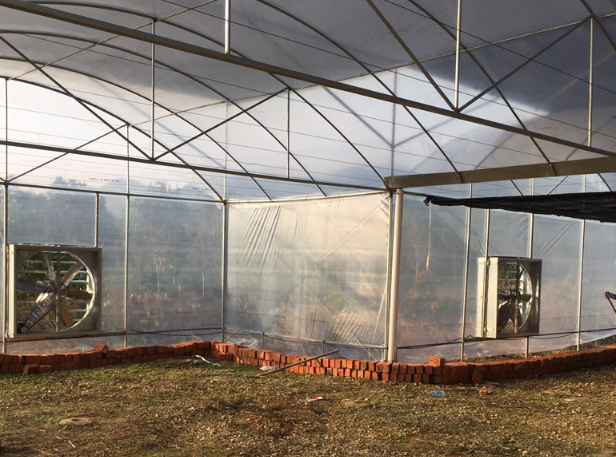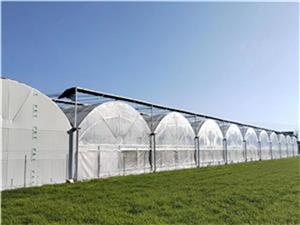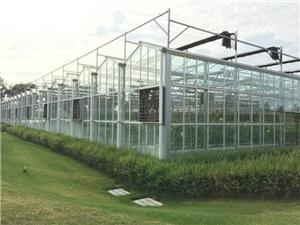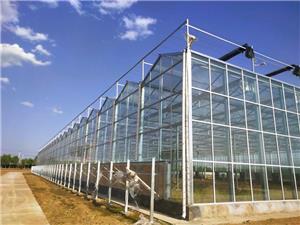Greenhouse Cooling Methods
1. Fan and Pad Cooling System
First and foremost, ventilation is an extremely crucial measure for film greenhouses. Properly opening vents to allow free air circulation ensures that heat inside the greenhouse is removed in a timely manner, maintaining fresh air.
Greenhouses primarily require cooling in summer, and fan-and-pad systems are one of the main cooling systems for summer greenhouse cooling. Below is a brief introduction to how to use fans and wet pads for cooling in summer.
Fan Selection: The fans used with wet pads are generally negative-pressure fans, usually installed at exhaust outlets to achieve forced air circulation. Compared with circulation fans, negative-pressure fans have a larger air volume and faster air circulation; when combined with wet pads, they achieve a cooling effect.
Cooling Principle of Wet Pads: Wet pads must be used in conjunction with fans, as only the penetrating air flow can achieve a cooling effect. When dry and hot outside air passes through the wet pads (wet media), the wet pads release a large amount of water vapor. The water vapor absorbs heat in the air, making the air moist and cool. This principle is known as evaporative cooling.
Factors Affecting the Cooling Effect of Wet Pads:
Poor quality of wet pad paper, leading to low water absorption.
Non-standard and unreasonable corrugation height of wet pad paper. A higher height results in a smaller expanded area and thus a weaker cooling effect.
Cleanliness of wet pads. Clogging with debris will affect air permeability and the uniformity of water flow.
Higher outdoor humidity will reduce the cooling effect of wet pads.

2. Circulation Fans
Purpose: To organize air flow inside the film greenhouse,cooling system ensuring uniform air distribution indoors and cooling system also achieving a certain dehumidification effect.
Characteristics: Small diameter, simple structure, usually with a small air volume but a long air supply distance.
Note: When using negative-pressure fans (as part of the fan-and-pad cooling system) in summer, circulation fans should be turned off.
3. Shading Systems
Shading systems for film greenhouses are divided into internal shading and external shading systems, both of which serve as important auxiliary cooling systems.
External Shading Systems: Mainly refer to covering the exterior of the greenhouse with shading nets. This method directly blocks solar radiation outside the greenhouse, effectively reducing the temperature inside the film greenhouse.
Internal Shading Systems: Installed inside the greenhouse, above the crop canopy, usually using relatively lightweight aluminum foil shading nets. Obviously, this type of shading system installed indoors cannot actually lower the indoor temperature; it can only effectively prevent direct sunlight from reaching crops and avoid sunburn. Typically, internal shading systems are used in combination with external shading systems.
External shading systems use tools such as shading nets to block excess sunlight outside the greenhouse, creating a shaded area to protect crops inside and keep the temperature in the film greenhouse within a suitable range. This can effectively block direct sunlight from crops without affecting natural ventilation inside the greenhouse. Cooling systemcooling effect is better than that of internal shading systems, but they require external shading materials to be sturdy, durable, less elastic, and anti-aging.
4. Micro-Mist Systems
Spray cooling is also a feasible cooling method for film greenhouses.
Greenhouse Interior Spraying: The main approach is to spray water into the greenhouse in the form of mist particles. These cooling system mist particles evaporate quickly, rapidly absorbing heat in the air; the moist air is then discharged outside the greenhouse, achieving the goal of rapid cooling.
Roof Spraying: Another method is to spray water on the roof of the film greenhouse, using the evaporation of water to take away heat.
In addition, increasing the frequency of irrigation is also a key step for greenhouse cooling. Properly increasing watering frequency allows water to evaporate and absorb heat, which helps reduce the temperature inside the film greenhouse.
In conclusion, by comprehensively applying the above-mentioned cooling systems and methods, film greenhouses can still maintain a relatively suitable temperature during sustained high-temperature weather, providing a favorable environment for crop growth and ensuring the smooth progress of agricultural production.





